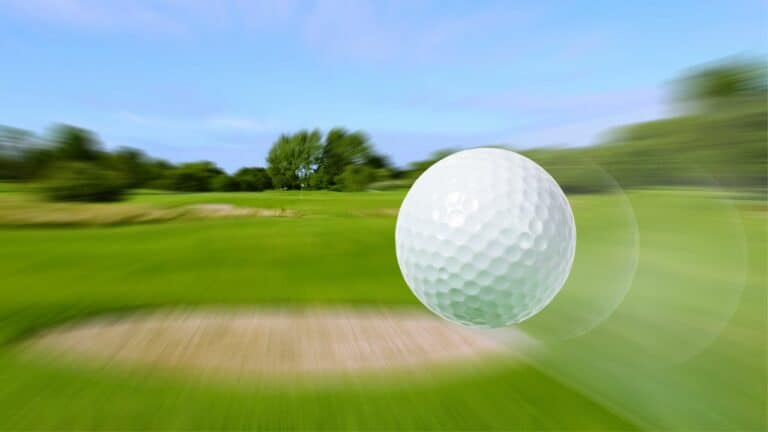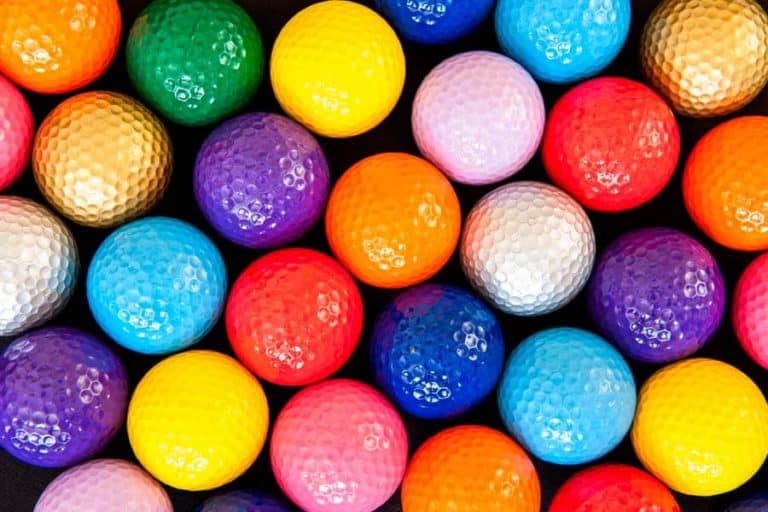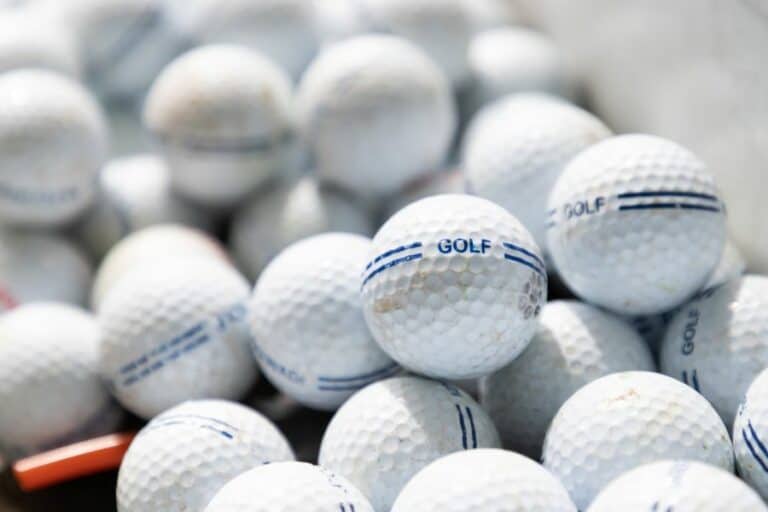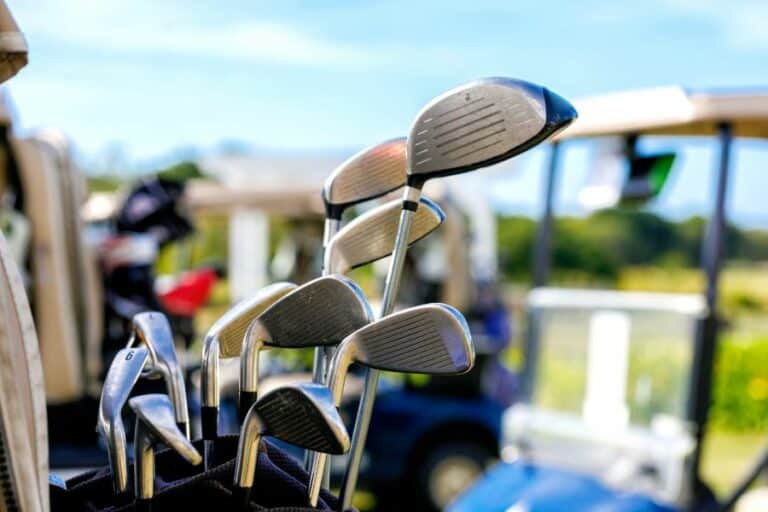MOI In Golf Clubs – What Is It and Why Is It Important?

Improve your golf game with a better understanding of MOI in golf clubs. Learn how this key factor affects your swing and shot accuracy.
Golf clubs’ MOIs are crucial because they determine how well they can withstand twisting when they make contact with the ball, which can significantly alter the shot’s accuracy, consistency, and distance.
I. What exactly is MOI in golf clubs?
The term MOI stands for a moment of inertia. It is a measurement of an object’s resistance to rotational motion. In golf, a clubhead’s MOI gauges how much it can strike the ball without twisting around its center of gravity. A club with a greater MOI is more stable through impact, which might result in a straighter and more reliable shot.
II. MOI and gear effect
When a golf club has a higher MOI, it activates more gear effects during mishits. The gear effect refers to the resulting starting direction and spin when the ball is struck away from the club’s center point.
For instance, hitting a shot on the toe causes the face to twist away from the target, introducing a “draw” spin that helps the ball curve back toward the target line. Similarly, a shot on the heel produces the opposite effect.
Despite gear effects providing some correction, hitting the ball in the center of the club’s effective sweet spot remains crucial for achieving the straightest and most consistent shots. While the gear effect can add a level of correction, aiming for the sweet spot ensures optimal performance and accuracy in your golf shots.
III. How MOI influences your shots: Importance for golfers
MOI should be taken into account when selecting a golf club because it has an impact on the player’s capacity to hit precise and reliable shots.
A higher MOI can provide more forgiveness on off-center hits and lessen clubhead twisting or rotation at impact. This can result in a more constant and straighter ball flight, particularly on misses. A lower MOI, on the other hand, can provide better input and control for talented players who can consistently strike the sweet area of the clubface.
It’s important to note that a club’s MOI is only one of several aspects that can influence your shots. Loft, lie angle, shaft flex, and clubhead design are all essential considerations. Furthermore, your swing mechanics and ball-striking abilities have a big impact on the outcome of your shots.
IV. How is MOI measured?
The measurement of MOI is in grams per centimeter squared, which indicates the level of resistance a clubhead exhibits against twisting. A higher MOI reading implies greater resistance, resulting in a club that is more forgiving to golfers during play.
V. The science behind the MOI by USGA
Golfers who want to improve their swing and hit the ball with more power, accuracy, and consistency should understand two important concepts: torque and moment of inertia.
Torque: Torque is the force that makes an object rotate around an axis. In golf, the axis is the player’s body, and the force is the swing. The more torque a player can generate, the faster the clubhead will move, resulting in a more powerful swing. Players can increase their torque by using a longer club or widening their stance to generate more force from their legs and hips.
Moment of Inertia: According to USGA, moment of inertia refers to the distribution of weight in the clubhead. The more evenly distributed the weight, the higher the moment of inertia. That’s why modern golf clubs often have larger clubheads and are made from lightweight materials like graphite or titanium.
Using the right amount of torque and moment of inertia is crucial for hitting the ball straight. However, mastering these skills takes years of practice.
USGA Limit for MOI
The higher a driver’s MOI, the more it resists twisting on off-center hits and the better it performs when golfers hit the ball outside the center. The current allowable USGA limit for MOI is 5,900 g/cm², and a few drivers in the market come close to that number.
VI. How is the right MOI determined for each golfer?
Golfers often have “favorite clubs” they consistently perform well with. This preference is due to these clubs having an MOI that aligns better with the golfer’s strength and swing mechanics. Clubmakers can find the right MOI by measuring a golfer’s favorite club and matching others to it. Another method involves building test clubs based on fitting recommendations, adjusting headweight for comfort and on-center hits.
VII. High and Low MOI – What is better for you?
For most golfers, picking a high MOI club is beneficial. A club with a higher MOI transfers energy more effectively on mishits, resulting in a smaller decrease in ball speed on off-center strikes. Higher MOI clubs offer a wider sweet spot and more forgiveness.
On the other hand, if you prioritize control and shot shaping, then low MOI clubs may be more suitable. To find the right club, it’s recommended that you try out different golf clubs and get fitted by a professional.
IX. MOI in Driver/Fairway Woods
Your fairway tee shots depend on your golf club’s MOI. When MOI is high and weight is far from the clubface, twisting is reduced. Despite an inaccurate swing, the clubhead is squared upon contact for higher launch and topspin.
Drivers with high MOI can help golfers achieve more stability and forgiveness, especially when hitting the ball off-center. This can result in a straighter shot even if the ball is not struck perfectly. It is recommended for golfers with slower swing speeds to consider high MOI drivers as they can generate more ball speed and distance.
X. MOI in Iron/Wedges
Golf irons were once blade-shaped. Back then, a mishit iron shot meant a massive miss. Irons work differently now.
Even if your swing speed is average, hitting the iron low on the face or off-center will make it fly much further and straighter. Senior golfers with slower swing rates should use these forgiving irons.
If you want to manage spin and hit more fades and pulls as your consistency improves, consider switching from larger headed, chunkier cavity-backs to blade-style wedges.
Blade-style wedges have a simpler design and lower MOI, which emphasizes shot-making and control over forgiveness. This can result in less forgiveness on off-center hits, but skilled players who prioritize shot-shaping and precision may benefit from the increased feedback and control. The lower MOI allows for a more precise feel and greater shot-making ability, which can be advantageous around the greens.
XI. MOI in Putter
A high MOI putter can reduce twisting and maintain accuracy on off-center hits, which benefits golfers who struggle with consistent contact on the center of the putter face. However, a low MOI putter can offer more feel and control for golfers who prioritize shot-shaping and have a consistent stroke. Ultimately, the choice between high or low
MOI putters depends on personal preference and playing style.
XII. What is the difference between MOI and forgiveness?
There is not any significant difference between MOI and forgiveness. A club with a higher MOI is more forgiving on off-center hits. For instance, if a golfer strikes the ball with the putter head on the heel or toe, it can cause the head to twist, resulting in reduced ball roll and accuracy. This is the reason why golfers may fall short on putts if they fail to hit the ball in the center of the face.
XIII. How Do Manufactures of Golf Clubs boost MOI?
Golf club manufacturers can increase MOI by utilizing a variety of methods and features in their designs. Here are a few of the most popular methods:
1. Weight distribution
To attain a higher MOI, golf club makers might spread the clubhead’s weight. They can provide additional weight on the club’s heel and toe, which lowers twisting on off-center strokes and raises the MOI.
2. Clubhead size
The MOI of a clubhead will be higher if it is larger. Manufacturers of golf clubs can enlarge the clubhead, which will raise the MOI.
3. Multi-material construction
The clubhead can be made from a variety of materials, such as a mix of steel, titanium, and carbon fiber. They can position weight more effectively and increase MOI by mixing materials.
4. Perimeter weighting
Manufacturers can boost the MOI and improve the club’s tolerance for off-center smashes by adding weights to the clubhead’s perimeter.
5. Hollow construction
Certain golf clubs, particularly irons, can be made with hollow constructions, which enables designers to better redistribute weight in order to raise the MOI.
6. Shaft length and weight
The MOI of a golf club can also be impacted by the length and weight of the shaft. The MOI can be raised by using a heavier, longer shaft to give the club additional stability during the swing.
In general, golf club makers strive to create clubs with a high MOI since it enables players to hit the ball farther and with greater precision.
XIV. Why impose a limit on the moment of inertia?
Higher MOI can potentially diminish the challenge of the game by making it easier to hit the ball straight, impacting the skill required. This could also lead to increased average driving distance as faster swings become less likely to produce poor results.
In 2005, the USGA observed a threefold increase in driver head MOI over 15 years. While acknowledging the potential for further MOI growth with advanced materials, the USGA expressed concern about compromising the game’s challenge.
Research indicated that existing clubhead size limits wouldn’t effectively prevent MOI increases. Despite permitting substantial MOI growth, the USGA now believes setting a limit is appropriate to maintain a balance in the game’s difficulty.
Conclusion
The higher the MOI, the greater the forgiveness. This applies to all golf drivers, woods, hybrids, irons, wedges, and putters. With wedges and putters, forgiving does not imply hitting straighter and longer. Forgiveness with wedges is mainly about targeting flags, but high-MOI putters are the most forgiving since they sink more putts. Many golfers, especially beginners, do not consider MOI when selecting clubs, let alone understand what it means and what it does. Mis-hits between the tee and the green are greatly reduced if your golf clubs have a high MOI rating. The lower your handicap, the more you’ll want to experiment with alternative equipment with lower MOI to improve your shot-making abilities.
FAQ’s
I. What Happens If MOI Is Too High In Golf Clubs?
When MOI (Moment of Inertia) is too high in golf clubs, skilled players may experience a loss of feel and control. This is because the weight is distributed towards the perimeter, making it difficult to shape shots and control trajectory.
II. Does MOI Matter In Irons?
While most golfers associate MOI with driver designs, it can be useful on all clubs in the bag. The higher the MOI of your irons, the more stable they become at impact and the better your chances of hitting them online and at the proper distance.
III. Is there a limit for MOI?
The USGA and R&A have established a maximum MOI limit of 5900 g/cm² for golf clubs.








